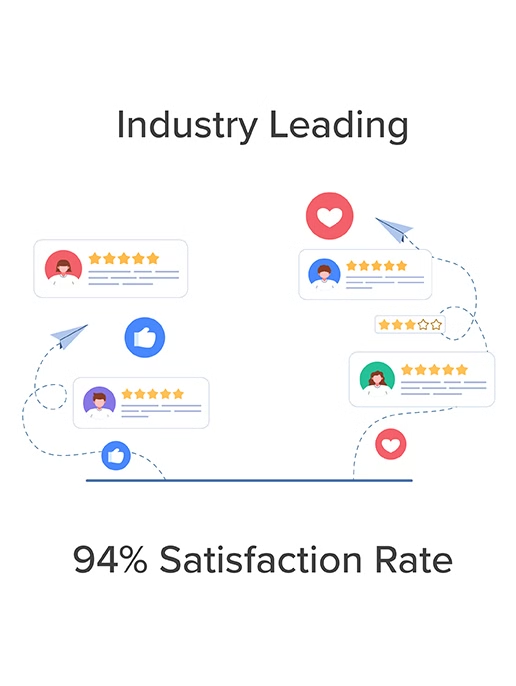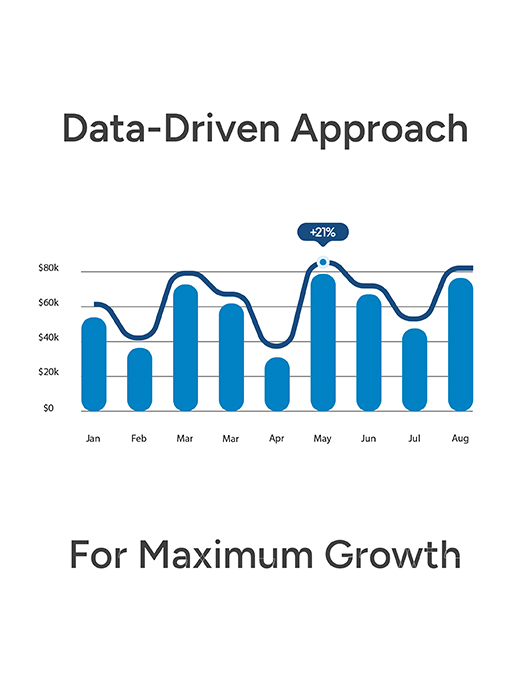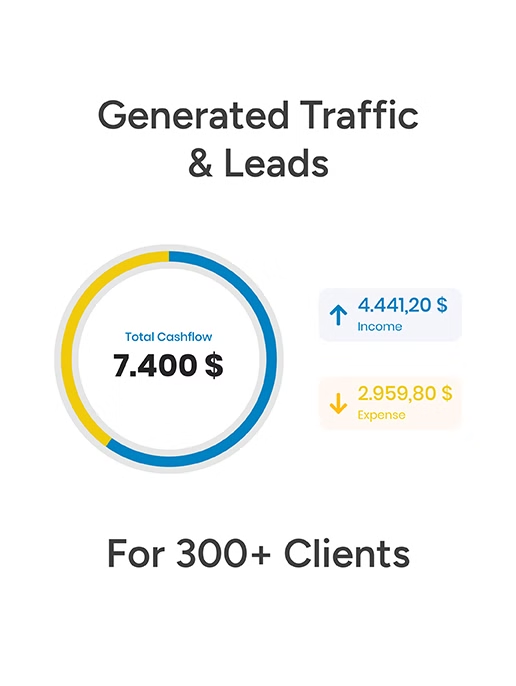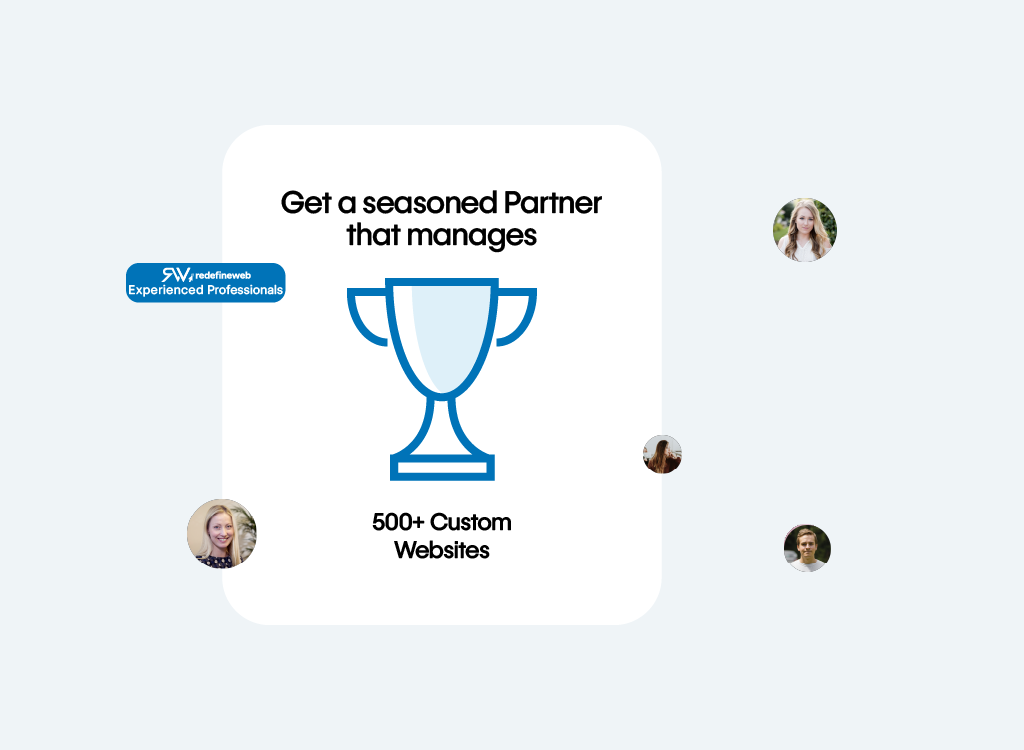


A reliable web development company typically charges between $4,000 and $10,000 to create a professional website for your tax or accounting firm.
For many firms, this represents a major budget challenge, often limiting their ability to invest in marketing and online visibility.
Instead, choose one of our Tax & Accounting website packages and get started with a free starter website. We’ve designed these plans specifically for accounting professionals and tax consultants, addressing common challenges such as service presentation, credibility building, SEO optimization for local clients, and clear content that reflects your expertise.
With our comprehensive website packages, we handle all the technical details—from design to development and on-page SEO—so you can focus on what you do best: helping clients manage their finances accurately and efficiently.

A professional website is essential for any tax or accounting firm looking to build credibility and attract new clients. However, even the simplest website builders can take hours before you can launch a polished, compliant site that reflects your expertise.
At Redefine Web, we provide all-inclusive solutions designed specifically for tax professionals and accounting practices — covering everything from design and development to SEO, content, and client engagement tools.
We work closely with you to understand your firm’s services, compliance requirements, and target audience, tailoring each element to your goals. This comprehensive approach helps your firm stand out from competitors, build trust with clients, and grow your business online.
Tax and accounting professionals often struggle to find affordable, effective options for building a website that truly represents their firm. Many solutions come with hidden fees or steep price increases once the initial contract ends.
Instead of wasting valuable time comparing complicated plans, partner with our experienced web designers who specialize in websites for tax and accounting firms. We’ll create a professional, compliant, and trust‑building online presence that showcases your expertise and attracts your ideal clients.
Best of all, every website we build is designed with future growth in mind. Whether you’re expanding your services, adding a client portal, or integrating new technology, we’ll be here to help you implement it seamlessly.

| Feature | Essential | Growth | Business | Custom |
|---|---|---|---|---|
| Design/Retainer Hours | 5 Hours (One-time) | |||
| Security Patches | ✓ | ✓ | ✓ | ✓ |
| Full-site backup | Monthly | Weekly | Weekly | ✓ |
| Security Scan | Monthly | Weekly | Weekly | ✓ |
| Server Migration | ✓ | ✓ | ✓ | ✓ |
| Copywriting | ✓ | ✓ | ✓ | ✓ |
| Keyword Research | ✓ | ✓ | ✓ | ✓ |
| Blog Posts | ✓ | 1 | 1 | 1 |
| Text Updates | ✓ | ✓ | ✓ | ✓ |
| On-page SEO | ✓ | ✓ | ✓ | ✓ |
| Photos Update | ✓ | ✓ | ✓ | ✓ |
| Off-page SEO |
| Feature | Essential | Growth | Business | Custom |
|---|---|---|---|---|
| Server Side Caching | ✓ | ✓ | ✓ | ✓ |
| HTTP Protocol | ✓ | ✓ | ✓ | ✓ |
| OpCache | ✓ | ✓ | ✓ | ✓ |
| Mod_Expires | ✓ | ✓ | ✓ | ✓ |
| Browser Cache | ✓ | ✓ | ✓ | ✓ |
| Brotli Compression | ✓ | ✓ | ✓ | ✓ |
| CDN | 82 POPs | 82 POPs | 82 POPs | 82 POPs |
| Feature | Essential | Growth | Business | Custom |
| Email Forwarders | ✓ | ✓ | ✓ | ✓ |
| Catch-all Emails | ✓ | ✓ | ✓ | ✓ |
| Email Aliases | ✓ | ✓ | ✓ | ✓ |
| IMAP/POP3/SMTP | ✓ | ✓ | ✓ | ✓ |
| Autoresponders | ✓ | ✓ | ✓ | ✓ |
| Filters | ✓ | ✓ | ✓ | ✓ |
| MX/SPF/DKIM Records | ✓ | ✓ | ✓ | ✓ |
| Email Virus Scanner | ✓ | ✓ | ✓ | ✓ |
| Feature | Essential | Growth | Business | Custom |
|---|---|---|---|---|
| Design/Retainer Hours | 5 Hours (One-time) | |||
| Security Patches | ✓ | ✓ | ✓ | ✓ |
| Full-site backup | Monthly | Weekly | Weekly | ✓ |
| Security Scan | Monthly | Weekly | Weekly | ✓ |
| Server Migration | ✓ | ✓ | ✓ | ✓ |
| Copywriting | ✓ | ✓ | ✓ | ✓ |
| Keyword Research | ✓ | ✓ | ✓ | ✓ |
| Blog Posts | ✓ | 1 | 1 | 1 |
| Text Updates | ✓ | ✓ | ✓ | ✓ |
| On-page SEO | ✓ | ✓ | ✓ | ✓ |
| Photos Update | ✓ | ✓ | ✓ | ✓ |
| Off-page SEO |
We often send out our newsletter with news and great offers. We will never disclose your data to third parties and you can unsubscribe from the newsletter at any time.
Unfortunately, we’re unable to offer free samples. As a retailer, we buy all magazines from their publishers at the regular trade price. However, you could contact the magazine’s publisher directly to ask if they can send you a free copy.
You can create a new account at the end of the order process or on the following page. You can view all of your orders and subscriptions in your customer account. You can also change your addresses and your password.
No, you don’t have to create an account. But there are a few advantages if you create an account.
You never have to enter your billing and shipping address again
Find all of your orders, subscriptions and addresses in your account
Download invoices of your orders
No, we don’t have a physical store location at the moment. We accept only orders through our online shop and we’re shipping all orders with the Swiss Post Service. Please visit our shipping section for more details.
From time to time you will find us at design fairs and popup markets in Switzerland. Subscribe to our newsletter and you’ll receive the latest news.
To ensure smooth, high-speed performance for all clients, we set a soft traffic limit that easily supports the average tax firm’s operations. If your site starts attracting more visitors—which means your marketing is paying off—we’ll help you upgrade seamlessly to a plan with greater capacity, faster speeds, and advanced tools to keep your growth uninterrupted.
To ensure smooth, high-speed performance for all clients, we set a soft traffic limit that easily supports the average tax firm’s operations. If your site starts attracting more visitors—which means your marketing is paying off—we’ll help you upgrade seamlessly to a plan with greater capacity, faster speeds, and advanced tools to keep your growth uninterrupted.
Every paid plan includes domain-based email addresses (e.g., info@yourtaxfirm.com, support@yourtaxfirm.com) for professional, secure communication. Having dedicated inboxes for client inquiries, billing, and support builds trust and keeps your team organized while giving your firm a polished, reliable image.
Your package includes dedicated design hours to tailor your tax firm’s website. Our designers use this time to align your chosen layout with your firm’s branding—adjusting colors, structure, and visuals to match your professional identity. If you’d like extra customization such as service pages or resource hubs, additional design hours can be added anytime.
Our team uses these hours to ensure your site reflects your brand’s professionalism and credibility. We’ll customize visuals, layout, and messaging so your firm stands out. These hours create a strong foundation for your site, with options to expand or refresh as your firm grows or tax regulations change.
Yes. If you prefer full ownership of your tax firm’s website and want to manage hosting yourself, our buyout option gives you complete control. We’ll provide all design files, assets, and step-by-step transition support—so your firm can retain full rights and scalability on your terms.
Most tax firm websites are completed within 30 days, depending on how quickly we receive your branding materials, text, and images. More advanced packages—including client portals, scheduling tools, or marketing integrations—may take slightly longer. You’ll always receive a clear, confirmed delivery timeline before kickoff.
Yes, you can supply your firm’s copy, team bios, and professional photos. However, if you’d rather focus on clients, our content team can handle it for you—writing persuasive, SEO-rich copy that highlights your expertise, certifications, and services to attract more local clients seeking tax help.
Absolutely. Every tax firm has unique goals. Choose from add-ons such as Local SEO, Google Ads management, or content creation for services like tax planning, bookkeeping, or IRS representation. You can expand or customize your site anytime to match your firm’s evolving needs.
We guarantee 99.9% uptime on all hosting plans. Your site will remain available when clients need you most—especially during peak tax seasons. All plans include SSL encryption, malware protection, and 24/7 monitoring to ensure your site performs securely and reliably around the clock.
Heat mapping shows how visitors interact with your website—tracking clicks, scrolls, and the pages they spend the most time on. For tax firms, this means you’ll see which services (like “Tax Preparation” or “Business Consulting”) attract most attention, helping us refine your layout to increase calls, form submissions, and consultations.
UX (User Experience) analysis helps pinpoint how easy—and enjoyable—it is for clients to use your site. We assess navigation, layout, and flow to ensure visitors can instantly find tax services, pricing, or contact options. Better UX means higher conversions, stronger SEO, and happier clients who choose your firm with confidence.
Our performance optimization service keeps your tax firm’s website fast, secure, and polished. We continuously refine speed, code, and responsiveness to reduce bounce rates and improve rankings. A quick-loading site shows professionalism—and ensures potential clients stay and convert.
You’ll have a dedicated account manager and access to our online client portal for ongoing communication. Get updates, request support, and—if you’re using our marketing services like Google Ads—schedule review meetings to track progress and fine-tune results.
Our complimentary Google Ads audit for tax firms evaluates how effectively your campaigns are reaching potential clients. Once granted read-only access, our team will:
You’ll get a detailed, actionable report with steps to lower wasted spend, generate more qualified leads, and achieve stronger, more consistent results.
Optimization focuses on performance—speeding up your website so it loads quickly and delivers a smooth experience for visitors. This includes cleaning up code, compressing images, and implementing caching for faster page loads. A well-optimized tax firm website keeps prospects engaged and encourages them to reach out.
Maintenance, on the other hand, ensures reliability and security. We regularly update plugins and themes, strengthen protection against vulnerabilities, and resolve technical issues before they affect performance. In short, optimization enhances client experience, while maintenance keeps your website secure and running flawlessly.
Our maintenance services keep your website fast, stable, and secure—critical during busy seasons. We fine-tune code, optimize images, and ensure all tools (like contact forms and client portals) load quickly on every device. We also manage ongoing software updates, monitor performance, and fix technical issues promptly. This means your clients can easily find information, request consultations, or upload documents without frustration—while you focus on serving them.
Core Web Vitals measure how quickly your website loads, how responsive it feels, and how visually stable it remains as it loads. These are key ranking factors used by Google to evaluate user experience. For tax firms, strong scores not only improve search visibility but also build trust—helping potential clients stay longer, view more pages, and ultimately contact your firm for assistance.
Clear communication is essential to ensure your new website meets your goals. You’ll have access to our project management system for regular updates and a dedicated project manager (depending on your plan) who will answer questions and share progress reports. After launch, you can use your client dashboard to request support or updates. If you’re also using our marketing services, your manager will schedule strategy calls to review performance and fine-tune campaigns for consistent client growth.
We treat the security of your website—and your clients’ confidential financial data—with the utmost care. Every plan includes enterprise-level protection powered by CloudLinux and Imunify360, which defends your site from malware, hacking, and unauthorized access. We perform regular vulnerability scans, secure contact forms, and leverage QUIC.Cloud’s CDN with Layer-7 DDoS protection. Our robust security stack keeps your tax firm’s website protected, stable, and compliant year-round.
Yes. If you already have a website, our team will handle the full migration for you—from moving content and images to transferring databases. The process involves minimal downtime, and after migration, your site will be faster, more secure, and easier to maintain on our optimized hosting environment.
Absolutely. Every tax firm website package includes automatic, off-site backups stored in secure data centers. In the rare event of a problem, we can restore your site quickly, ensuring your clients can still access important pages, portals, and contact forms without disruption.
We manage all updates and security patches carefully through a tested staging process. First, we verify each update in a safe environment to ensure all tools—especially document upload forms and client contact features—work perfectly. Once tested, we deploy updates to your live site without downtime. With any plan, your site benefits from proactive maintenance and continuous monitoring for maximum reliability.
No. Backup restoration is fully included in every package. If an update or unexpected issue ever occurs, we’ll quickly restore your site at no additional cost—keeping your online visibility, lead forms, and client access uninterrupted.
We use multiple layers of advanced protection to secure your site. Our servers include firewalls, real-time malware scanning, and intrusion detection systems that stop threats before they reach your website. QUIC.Cloud’s CDN provides global Layer-7 DDoS protection, while our team implements security patches the moment they’re released. The result is a safe, compliant, always-online website that your clients can trust.
Yes, we do! Our SEO and PPC management services are built to help tax professionals reach more clients and stand out when people search for financial and tax help in your area. A professional website sets the foundation—visibility fuels growth.
Our SEO strategy targets high-value keywords such as “tax accountant near me” or “small business tax preparation in [your city].” We handle keyword research, on-page optimization, content creation, and link-building to grow your authority over time. To generate immediate leads, we often pair SEO with PPC campaigns that position your firm at the top of Google search results for the most profitable terms. Together, these strategies deliver a steady flow of qualified client inquiries year-round.
We start by getting to know your firm—your goals, specialties, and target clients. Using advanced tools like SEMrush and Google Keyword Planner, we identify the most effective search terms, such as “business tax services in [city]” or “IRS audit help near me.” Our content team then writes optimized, client-focused copy that improves rankings and drives qualified traffic. The result: more visibility, more calls, and more clients choosing your firm.
We optimize every detail of your tax firm’s website for performance, ranking potential, and user experience. That includes refining page titles, meta descriptions, headings, image tags, and internal links. We also ensure your site is mobile-friendly and easy to navigate—helping visitors quickly find your services, learn about your expertise, and request consultations while signaling strong relevance to search engines.
Our content specialists produce engaging, professional copy that builds credibility and explains your services clearly. After researching your audience, competitors, and service offerings—whether it’s tax preparation, bookkeeping, or representation before the IRS—we create informative pages and articles that answer real client questions and build trust. Each piece follows SEO best practices to increase visibility, attract qualified leads, and strengthen your online reputation.
Yes. Local SEO is crucial for attracting nearby clients. We optimize your Google Business Profile, manage citations, and help generate authentic client reviews to increase your visibility in “tax firm near me” searches. We aim to make your firm the trusted first choice for individuals and businesses looking for expert tax help in your area.
We provide clear, easy-to-understand reports that highlight your results. You’ll see key metrics such as keyword rankings, website traffic, lead submissions, and phone inquiries. For PPC, we share data on cost per lead, conversion rates, and overall ROI. Your account manager walks you through every report, discussing improvements and adjusting strategy to keep your lead generation on track and growing.
We offer flexible, transparent packages tailored to your goals and budget. SEO plans can include keyword optimization, ongoing content creation, local profile management, and technical audits. PPC pricing is based on your ad spend and campaign complexity—with full transparency at every step. You’ll know exactly how your investment is being used to generate measurable results and consistent new client leads.
Typically, noticeable improvements begin within 3–6 months, depending on your website’s current performance, competition, and location. SEO is an ongoing growth strategy, not a one-time fix. As we optimize your content, strengthen backlinks, and enhance site structure, you’ll see steady increases in search rankings, visibility, and inbound client requests.
Our PPC campaigns are custom-built for your services—whether you focus on small business taxes, personal returns, or IRS representation. We target high-intent keywords such as “tax help in [city]” or “CPA for small business.” Ad copy and landing pages are carefully aligned to maximize lead quality and return on investment. Every campaign is continuously optimized to deliver more inquiries at lower acquisition costs.
We use precise audience targeting to reach the clients most likely to need your expertise. This includes location, income brackets, business types, and search intent. To stay top of mind, we also use remarketing ads that re-engage potential clients who visited your site but didn’t convert. Continuous performance monitoring ensures every dollar of your ad budget drives measurable results and higher-value leads.
Getting started is straightforward. Choose one of our tax firm website plans and share a few details—your logo, services, location, and design preferences. Once we have your information, our team manages the entire process from setup to launch, delivering a professional website that helps new clients easily find and contact your firm online. Tip: If you’d like help with content, our SEO copywriting add-on can handle everything—from service descriptions to keyword-optimized blog articles.
Yes! Every tax firm website we build includes an intuitive content management system. You or your team can update service pages, post blogs during tax season, upload team photos, or edit content at any time—no technical experience required.
Our packages include secure, high-performance hosting optimized specifically for tax firms. However, if you prefer to host elsewhere, you can transfer your site anytime after a one-time buyout fee. We recommend staying on our platform for peak speed, security, and full technical support to keep your site performing at its best.
Absolutely. Your team can easily add bios, success stories, tax tips, or blog posts whenever you’d like. The editing tools are straightforward and user-friendly. And if you’d rather have professionals manage content updates, our ongoing content creation add-on can handle it for you—keeping your site fresh and relevant year-round.
Our hosting plans are designed to grow with your firm. The standard plan supports around 10,000 visits per month, perfect for small to mid-sized teams. As your visibility increases, we’ll help you upgrade seamlessly for greater capacity, faster speeds, and continued reliability—all while supporting your expanding client base.
Yes. Every website we create is optimized for SEO from day one. We ensure fast load times, mobile responsiveness, and proper structure so your firm ranks higher in Google searches. To strengthen your results even further, our SEO add-on can optimize your content around valuable keywords like “tax accountant in [city]” or “business tax services near me.”
A design hour is time dedicated by our design team to fine-tune your website’s look and feel. During these hours, we customize your layout, colors, typography, and imagery to match your branding and professionalism. Our standard package includes four design hours—enough to create a clean, polished site. Additional hours are available if you’d like advanced customization.
Typically, yes—you’ll provide your text, team bios, and professional photos. But if you’d prefer a hands-off experience, our copywriting service can handle it for you. We’ll craft persuasive, SEO-optimized content that highlights your expertise, services, and trustworthiness—so your website attracts and converts visitors effectively.
Absolutely. Every tax firm has unique goals and technical requirements. Whether you need additional service pages, client portals, or a tailored design, we’ll prepare a personalized quote that fits your scope, objectives, and timeline.
Our managed hosting eliminates the technical hassle of running your tax firm’s website—so you can focus entirely on serving clients. You’ll have access to 500+ professional templates, including layouts built specifically for financial and tax professionals. Each plan includes four design hours to personalize your site with your logo, branding, and content—helping you launch quickly and confidently. You’ll also get five professional email accounts, secure daily backups, and 24/7 server monitoring. We manage all performance, updates, and security tasks, ensuring your online presence stays reliable, professional, and worry-free.
As your client base expands and website traffic increases, our hosting scales seamlessly with you. If you exceed 10,000 monthly visits, we’ll guide you through a quick upgrade—without downtime or disruption. You can also add marketing services like SEO, blog content, and paid campaigns to maintain long-term growth. Whether you’re a solo practitioner or managing multiple offices, our infrastructure ensures consistent performance at every stage of your firm’s success.
We take security seriously—especially when it comes to protecting client data. Our hosting is safeguarded with enterprise-grade firewalls, intrusion detection systems, and regular updates that meet strict data protection standards. With continuous monitoring and secure off-site backups, your website stays protected and recoverable at any time—keeping your firm’s reputation and client information safe.
Yes. We can migrate your existing website to our optimized hosting environment with minimal downtime and zero data loss. Our team transfers your pages, content, and settings while preserving your structure and SEO rankings. You’ll immediately benefit from faster performance, stronger security, and improved reliability.
If your site traffic surpasses 10,000 monthly visits, we’ll reach out to recommend a smooth upgrade—no interruptions, no surprises. Short-term spikes won’t trigger extra charges. Our flexible hosting adapts to your growth, ensuring your website remains fast and available as your client visibility increases.
Our data centers are located in North America and Europe. We’ll host your tax firm’s website in the region closest to your office to ensure faster load times, better search performance, and a seamless experience for visitors in your service area.
Yes. We tailor hosting packages to meet your specific business needs—whether you require extra storage, increased traffic capacity, or enhanced security layers. Our scalable plans evolve with your firm, ensuring your website remains fast, secure, and professional as your business grows.
Yes. If you already have a designed website, we can host it for you. You’ll enjoy premium speed, top-tier protection, daily backups, and proactive monitoring—all managed by our technical support team. It’s the ideal choice for tax professionals who want dependable hosting without full design or marketing services.
Export options are available to active subscribers. Monthly subscribers can export their content after one year, while annual plan holders may do so at any time. Should you decide to move your website elsewhere, we’ll coordinate the transition carefully to minimize downtime and ensure full accessibility during the move.
Buyout fees depend on the scope of customization and development work completed for your site. We always provide a clear, transparent quote so you can make an informed decision. The buyout option gives your firm full ownership and control—complete flexibility, on your terms.
